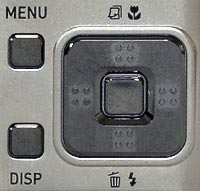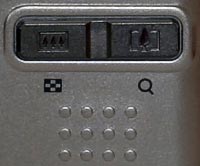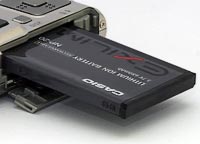Casio Exilim Card EX-S100
Review Date: February 28th 2005
|
Ease of Use
The Casio Exilim Card EX-S100 is the tiniest digital camera that I have ever reviewed, measuring just 8.8cms wide by 5.7cms high, 1.67 cms thick and and weighing only 113g. Consequently it is an extremely portable camera that can be carried around with you wherever you go, even in your shirt pocket. Being so small, it also has the benefit of not drawing too much attention from other people, making it a great choice for more candid moments. The body is made of a hard-wearing metal casing which has a shiny stainless steel kind of finish.
This camera is dominated externally by one feature - the large 2-inch LCD screen on the rear, which seems even bigger than it actually is because of the small size of the camera. The screen makes framing your images much easier than with smaller LCDs, with the added benefits of providing a menu system that has an easy-to-read large typeface, and bringing your pictures alive when you play them back. Larger LCD screens seem to be something of a growing trend at the moment. There are a couple of drawbacks, however, with having such a large LCD screen. First is the number of pixels - there are just 84,960 of them, which because the screen is so large results in the image being rather grainy. The effect isn't too noticeable, though, and the large size of the LCD more than compensates for it. Second, there is no optical viewfinder on the Casio Exilim Card EX-S100. If you don't like using LCD screens then you need to look at another model.
| Menu Button / Display Button / Control Pad | Zoom Buttons |
 |
 |
The Casio Exilim Card EX-S100 is extremely well-made, with nothing that feels as though it will fall off given enough wear and tear. Casio have done an excellent job in designing a camera that doesn't have too many buttons and switches to confuse the new photographer that this camera is aimed at. There are just 10 external controls in total, with all of them clearly labeled and understandable. The shutter button is large and tactile, and the other principal controls are also well sized, especially given the tiny dimensions of the camera and the large LCD screen that takes up a lot of space.
The menu system of the Casio Exilim Card EX-S100 is as well designed as the exterior of the camera. It uses an intuitive tabbed interface with 3 pages at the top of the screen - REC, Memory and Set Up - and 6 options shown onscreen at one time. The only drawback with this system is that all the record options - things like image quality, white balance etc - are in the same REC menu, which makes it 4 pages/screens long (19 options in total). This can initially make it frustrating to find the option that you're looking for. On the plus side, that large LCD screen really makes a difference to using the menu system, as all the options are clearly displayed in a generously sized typeface.
| Battery Compartment | On/Off Button / Shutter Release Button |
 |
 |
So what is the Casio Exilim Card EX-S100 like to actually operate and take a photo? The start-up time from turning the camera on to being ready to take a photo is respectable enough at around 1 second. Zooming the 2.8x zoom lens from the widest focal length to the longest is quick, taking less than 1/2 second. Focusing is very quick and responsive in good light and also indoors and in low-light situations - a refreshing change from some digicams that I have reviewed recently which have really struggled indoors. Both the refresh rate and visibility of that 2-inch LCD screen are good and it is visible even in bright sunlight. Images are stored quickly with the camera ready to take another image almost instantly. Overall a very snappy performance from the EX-Z55.
Once you have captured a photo, the Casio Exilim Card EX-S100 has a lot of options when it comes to playing, reviewing and managing your images. You can scroll through the images that you have taken, zoom in and out to a factor of x4, and view thumbnail versions of each image. You can play a slideshow and configure the time and interval settings and save a photo as a Favourite image that you can then playback. You can configure which images you want to print, selecting whether to print the date and how many copies you want to print.
You can crop an image using the trimming option, rotate and resize images, choose which images to Protect (to prevent them from being deleted), and delete an image. You can add sound to an image (called Dubbing), and even create an album of images, with 10 different layouts available. The Casio Exilim Card EX-S100 even has a histogram feature, both before taking a photo or after, which makes evaluating the exposure of a photo much easier than by simply looking at it onscreen. Overall the Casio Exilim Card EX-S100 has a multitude of playback options - the only missing ones that I can think of are effects like applying black and white or sepia filters.
I enjoyed using the Casio Exilim Card EX-S100. Being so quick and responsive, small and unobtrusive, as well as having that large LCD screen, made taking photos an easy and enjoyable experience - perfect for its target audience. The only potentially negative aspects that you should consider are the grainy LCD screen and the lack of an optical viewfinder. Otherwise the Casio Exilim Card EX-S100 is a great camera in terms of its ease-of-use.
|
 PhotographyBLOG is a member of the DIWA organisation. Our test results for the Casio Exilim Card EX-S100 have been submitted to DIWA for comparison with test results for different samples of the same camera model supplied by other DIWA member sites.
PhotographyBLOG is a member of the DIWA organisation. Our test results for the Casio Exilim Card EX-S100 have been submitted to DIWA for comparison with test results for different samples of the same camera model supplied by other DIWA member sites.
